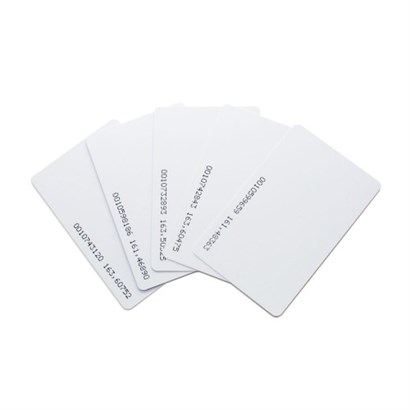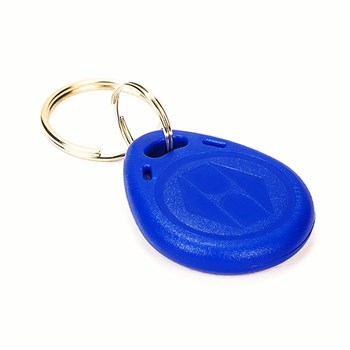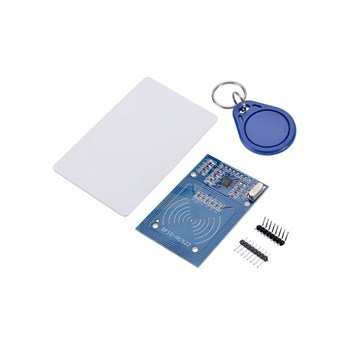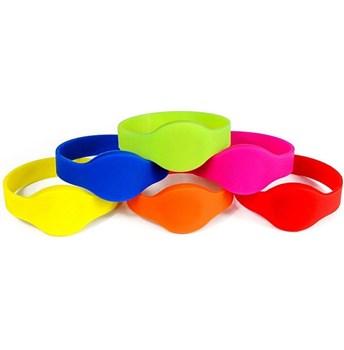کارت RFID دارای فرکانس ID Card ) 125KHz )
درباره این کالا بیشتر بدانید
کارت Radio-frequency identification که به اختصار RFID نامیده می شود وسیله ای برای شناسایی و کنترل افراد در کارخانه ها، شرکت ها، سمینارها، کارت های هوشمند، سیستمهای کنترل، بخش کنترل چمدان ها و کتابخانه ها می باشد. این کارت های شناسایی دارای یک مدار الکترونیکی می باشند که شامل آنتن و تراشه است. تراشه داخل کارت RFID دقیقا کارکردی مشابه بارکدها یا نوارهای مغناطیسی دارد و درست مانند آنها برای گرفتن اطلاعات نیاز به اسکن شدن دارد که به منظور کدگذاری و خواندن اطلاعات از تراشه ها استفاده می گردد.
کارت های RFID غیر تماسی(Contactless) هستند و برای اسکن شدن نیازی به تماس دقیق با اسکنرها ندارند و زمانی که تگ نزدیک یا در محدوده کدخوان (RFID Reader) قرار می گیرد میدان مغناطیسی تولید شده توسط کد خوان، باعث فعال شدن تگ می گردد و کارت به طور پیوسته اقدام به ارسال داده از طریق پالس های رادیویی می کند و در نهایت داده توسط Reader دریافت و توسط کامپیوتر، میکروکنترلر و یا پردازنده های دیگر پردازش و ارسال می شود.
مشخصات:
فرکانس: 125 کیلوهرتز
پروتکل: ISO10536(سازگار با EM4100 125KHZ)
مشخصه آی دی: 64بیتی
جنس مواد ساخته شده: پی وی سی
دمای کاری: 50+ ~ 20- درجه سانتی گراد
ابعاد: 0.86 * 54 * 85.6 میلی متر
Description:
Radio-frequency identification (RFID) uses electromagnetic fields to automatically identify and track tags attached to objects. The tags contain electronically stored information. Passive tags collect energy from a nearby RFID reader's interrogating radio waves. Active tags have a local power source (such as a battery) and may operate hundreds of meters from the RFID reader. Unlike a barcode, the tags don't need to be within the line of sight of the reader, so it may be embedded in the tracked object. RFID is one method of automatic identification and data capture.
Within the Electromagnetic Spectrum, there are three primary frequency ranges used for RFID transmissions – Low Frequency, High Frequency, and Ultra-high Frequency.
Radio frequency identification (RFID) and proximity identification (ID) are similar technologies. While RFID is used mainly in the shipping industry, proximity ID is primarily a security solution. Radio waves are the key component of both technologies.
Proximity ID is more commonly called a proximity card or a contactless ID card. These cards use an embedded antenna to communicate with a remote receiver.
Proximity cards are read-only devices and are mainly used as security cards for door access. These cards can hold a limited amount of information. According to Alpha Card, a leading installer of proximity card systems, the effective range of these cards is 2.5 inches to 3.9 inches.
The range depends on the type of reader being used.
RFID tags contain at least three parts: an integrated circuit that stores and processes information and that modulate and demodulate radio-frequency (RF) signals; a means of collecting DC power from the incident reader signal; and an antenna for receiving and transmitting the signal.
The tag information is stored in non-volatile memory.
The RFID tag includes either fixed or programmable logic for processing the transmission and sensor data, respectively.
The European Telecommunications Standards Institute (ETSI) is the governing body in Europe that sets and upholds country-wide standards for communicating via multiple channels, including Radio Waves.
By ETSI’s regulations, RFID equipment and tags are only allowed to communicate on the smaller frequency range of 865 — 868 MHz because other types of radio communications are allocated to subsets of the larger range of 860 — 960 MHz.
Because ETSI sets the standards for Europe, but when purchasing tags and equipment, the standard can be called either ETSI or EU denoting Europe. The plastic card in which the chip is embedded is fairly flexible, and the larger the chip, the higher the probability of breaking. Smart cards are often carried in wallets or pockets — a fairly harsh environment for a chip.
RFID cards are Contactless and they o not need to make direct surface contact to readers.
The readers produce a magnetic field that activates the tag and data communication. It should be considered that When two or more contactless cards are in close proximity the system may have difficulty determining which card is intended to be used.
The card-reader may charge the incorrect card or reject both. These RFID cards can be used in contactless payment systems. Contactless payments are payments made by waving or tapping your contactless device – usually a card or smartphone – over a reader, which then accepts the payment.
To pay for something with a contactless credit card, you hold the card near a payment terminal (known as an RFID reader) and it picks up the signal, communicates with the card and processes the payment.
What sets a potential RFID application apart from applications that can use other types of systems is the need to uniquely identify individual items quickly and more efficiently where traditional systems fall short. Below are a few applications that are successfully using RFID technology:
Access management, Tracking of goods, Tracking of persons and animals, Toll collection and contactless payment, Machine-readable travel documents, Smartdust (for massively distributed sensor networks), Airport baggage tracking logistics, Timing sporting events, Tracking and billing processes.
Features:
Frequency: 125KHz
Protocol: ISO10536 (125KHz EM4100 Compatible)
Unique ID: 64bits
Material: PVC
Temperature: -20°C ~ +50°C
Dimension: 85.6 × 54 × 0.86 ( mm )





اولین نفری باشید که نظر خود را ثبت می کند.
برای ثبت نظر ابتدا باید به سایت ورود کنید.
ورود/ثبت نام